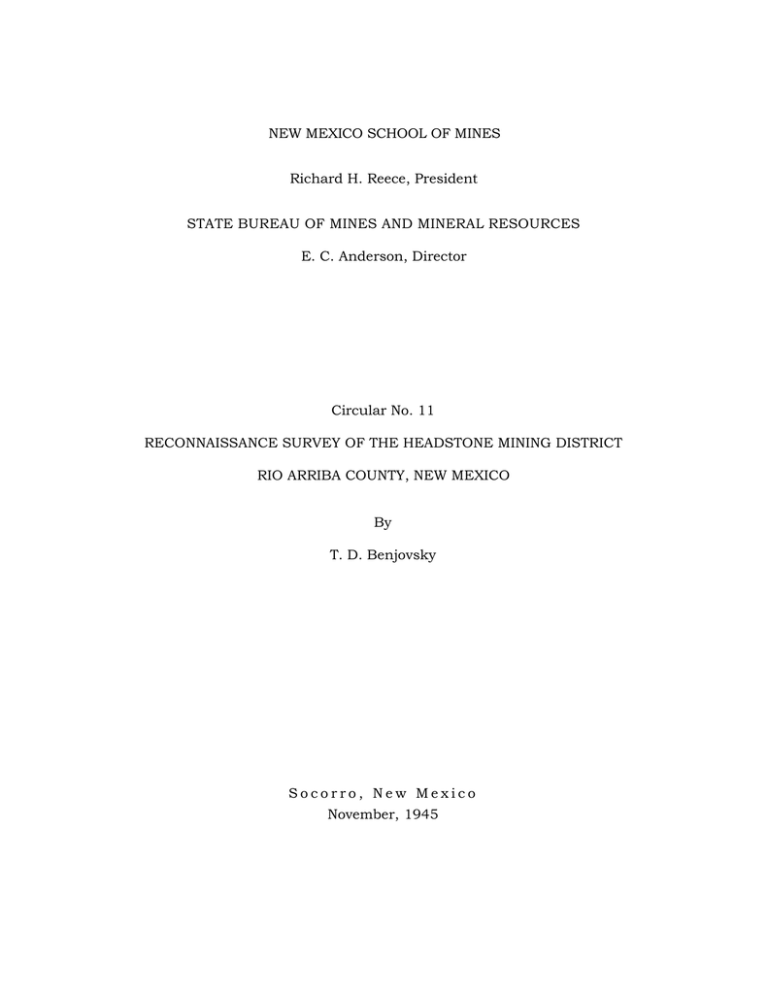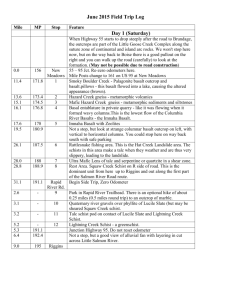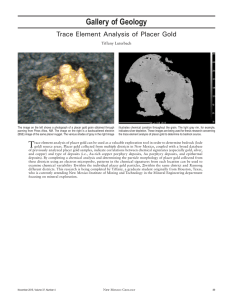NEW MEXICO SCHOOL OF MINES Richard H. Reece, President
advertisement

NEW MEXICO SCHOOL OF MINES Richard H. Reece, President STATE BUREAU OF MINES AND MINERAL RESOURCES E. C. Anderson, Director Circular No. 11 RECONNAISSANCE SURVEY OF THE HEADSTONE MINING DISTRICT RIO ARRIBA COUNTY, NEW MEXICO By T. D. Benjovsky Socorro, New Mexico November, 1945 RECONNAISSANCE SURVEY OF THE HEADSTONE MINING DISTRICT RIO ARRIBA COUNTY By T. D. Benjovsky INTRODUCTION Looking ahead to a probable post-war revival of gold mining in New Mexico and the need for information on the State's gold districts, the State Bureau of Mines and Mineral Resources has undertaken the examination of some of the most promising former gold-producing areas. After considering the history and records of many of these areas, it was decided to give first attention to the Headstone district in northeastern Rio Arriba County. First authorized by A. D. Hahn, formerly Acting Director of the Bureau, the project has resulted in the present report and map, which have been made general rather than detailed and cover only the more promising part of the district. Field work was carried on during July and August 1945. The surveying and preparation of the map were done by E. L. and Alda Murusky, under the general direction of T. D. Benjovsky. LOCATION The area considered in this report includes the main part of the Headstone mining district and consists of all sec. 31 and the W 1/2 sec. 32, T. 29 N., R. 7 E., and the NW 1/4 sec. 1, T. 28 N., R. 8E., northeastern Rio Arriba County, New Mexico. It is a part of what was originally the Hopewell mining district, which also included an area to the southeast later separated as the Bromide district. The village of Hopewell is located in the east central part of the Headstone district (see map, Plate 1), and has always been headquarters for mining operations. The district lies within the Carson National Forest. Hopewell is reached over a semi-improved dirt road from the junction of Deer Trail and Tusas canyons 5 miles to the east. From this point an improved National Forest dirt road and State Highway 110 connect with U. S. Highway 285 at Tres Piedras 15 miles to the east, and with La Madera 31 miles to the south. The nearest railroad station is Antonito, Colorado, on the Denver and Rio Grande Western Railroad, distant some 28 miles to the north. The narrow- gauge line of this railroad that extended from Antonito to Santa Fe was abandoned in 1938. HISTORY The mining history of the Hopewell area begins in July 1881, with the discovery of silver by D. M. Field and J. M. Bonnet in what is now the Bromide district. Immediately following this discovery, placer locations were made in the present Headstone district, in and near the village of Hopewell. Migration to the Headstone district was stimulated by the fact that gold had been discovered there. Hundreds of claims were staked and the district seemed destined for a boom. Shallow shafts and tunnels, totaling many hundreds of feet, were driven on both sides of Eureka Creek gorge, and numerous claims were patented. Several small stamp and amalgamating mills came into operation. However, no bonanzas were discovered. The change from oxidized ore to sulfide ore at shallow depth, and the limited ore supply from the narrow veins, gave discouraging results under the mining conditions then prevailing. - 2- Consequently all lode work was suspended in the early 1890's. Minor amounts of placer gold were produced between 1890 and 1903, and following 1903 there was increasing interest in placer operations in Eureka Creek gorge and in the park below the junction of Eureka and Bear Creeks. The placer operations in the area are said to have produced $175,000 in placer gold between 1881 and 1903. This production was made by many individual operators, with simple hand-operated equipment. The gold was sold to Clarence Hood, a local merchant. In December 1903, J. P. Gill finished an elaborate plant at the lower placer in the park, using hydraulic principles of placering, and the following summer a limited amount of the total placer was washed. Hydraulicking was interrupted by failure of dams that had been constructed on Eureka Creek at Hopewell. This failure, together with financial and tailings-disposal troubles and the fact that yield recovered per yard of washed ground was not what was expected, caused operations to be suspended. Later, heavy run-off from excessive rainfall washed out pipe lines, bridges and sluices, and resulted in abandonment of the whole project. Information obtained from long-time residents and from published reports indicates that up to 1940 the district had produced from placer operations a total of $285,000, the greatest part of which came from Eureka Creek gorge. The search for gold, always stimulated in times of depression, and the increase in price from $20.67 to $35.00 per ounce, caused a revival of interest in the Hopewell district in the 1930's. During favorable seasons in this period some 20 to 25 individuals made a comfortable living from hand-operated placering and minor lode operations in Eureka Creek gorge. The gold recovered was 900 to 950 fine. In 1935, the Amarillo Gold Mining Company acquired a few patented lode claims, including Red Jacket, Mineral Point, Croesus, Little Casino, and -3 - possessory claims such as Buckhorn and Hoover Nos. 1 and 2. The company constructed a 30-ton mill on the south side of Eureka Creek at the top of the gorge. The mill consisted of crude-ore bin, jaw crusher, set rolls, a ball mill, and a 6-cell flotation machine with Wilfley tables as the final concentrating device. Advantage was taken of hillside slope in construction; the mill was powered by steam and was all under one roof. Ore was supplied from the Red Jacket and Mineral Point claims on the north side of Eureka Creek, and was transported from mine to mill by truck. As the above operation was not successful, the mill was remodeled and for more economical transportation a trestle was built from the mill across the creek to a tunnel that connected with the Red Jacket shaft. Power was furnished by two gasoline engines. Over a period of 5 months about 3500 tons of ore was treated, the bulk of which came from the Red jacket, Mineral Point and Croesus claims with a minor amount from the Buckhorn and Hoover No. 1 claims. According to unauthenticated reports, mill heads were Au 0.15 oz., Ag 1.0 to 1.5 oz., Pb about 0.5%, Cu 0.15%, and Zn 0.5%. The operation proved uneconomical and was discontinued in 1937; there has been no further lode activity in the district. The mill building and most of the equipment, including the gasoline engines, are still on the ground. POWER, TIMBER AND WATER The closest electric-power distribution line is at Antonito, Colorado, at the south end of the system of the Public Service Company of Colorado. Although the early operations were powered with steam, generated with wood cut in the area as fuel, no steam equipment is left in the district. Gasoline or Diesel power would be the solution for any immediate needs in a revival of the district. -4- The Headstone area supports a luxuriant growth of red and white spruce and aspen. Undergrowth characteristic of the high altitude is prevalent throughout the district. Grasses, wild flowers, and such minor vegetation grow profusely. Heavy winter snows and frequent rains in the summer and fall make for a good water supply the year around. Springs, some of which have been used for domestic purposes, are common. TOPOGRAPHY The Headstone district lies between 7800 and 9700 feet above sea level. It is a region of large broad-topped mountains and U-shaped valleys. Most of the slopes are gentle. In that part of the Eureka Creek valley immediately west of Hopewell, however, the creek occupies a narrow gorge, the average width of which at creek level is 50 feet. Steep walls on either side rise for about 125 feet at the upper end of the gorge and about 250 feet at the lower end. The total length of the gorge is less than 2500 feet. From the top of the gorge walls, the surface flattens out abruptly and slopes gradually upward to the summits of the surrounding mountains. GENERAL GEOLOGY Rocks exposed in the Headstone mining district include pre-Cambrian schist, quartzite, and granodiorite, Tertiary rhyolite, and Quaternary basalt. Outcrops are few and sparsely distributed. Fresh specimens of the schist are practically impossible to obtain because of intense weathering. The chief constituent minerals are quartz, muscovite, and biotite, with locally much hornblende and pyrite. Chlorite is a common mineral. The normal strike of the schist is N. 57 o W., with a dip of 78-84o to the northeast; the strike changes -5- perceptibly over short distances but the dip remains essentially constant. The schist underlies the surface on both sides of the Eureka Creek gorge, and extends for considerable distances to the north and south. Surface measurements indicate it to be approximately 2500 feet thick; it is also exposed in underground workings in the Little Casino mine, and may total as much as 4000 feet in thickness. The schist has a marked reddish color along its contact with the quartzite. This contact is readily identifiable in the field. The quartzite, which is in contact with the schist on the west and southwest, covers many square miles and is apparently thousands of feet thick. It is probably a continuation of the quartzite along Spring Creek and at La Madera some 20 miles to the southeast. Its strike and dip approximately parallel that of the schist. The mass of the quartzite is white, but brown bands occur that contain much specular hematite. Near the schist-quartzite contact, the hematite produces a red color. The granodiorite is a coarsely crystalline rock containing quartz, feldspar, and hornblende, with minor amounts of tourmaline and biotite. A definite schistosity is developed along faults. The schist-granodiorite contact north of Hopewell cannot be seen at the surface because of cover by alluvium; however, it is exposed in the tunnel of the Santa Fe mine. The granodiorite is doubtless continuous with that in the Tusas watershed and at Tres Piedras. A granodiorite mass was noted on the old road to Bear Gulch, north and west of the mapped area. A dike, apparently of rhyolite, crops out across Eureka Creek north of Hopewell and on Burned Timber Mountain to the south. Its strike is approximately north-south; no dip is obtainable. Several small erosion remnants of a basaltic flow were noted. -6- MINERALIZATION Mineralization has occurred in the stringers or veinlets in the schist, and in wider veins in the granodiorite north of Hopewell. Minerals include metallic gold, limonite, hematite, malachite, azurite, rutile and calcite in the oxidized zone, and pyrite, chalcopyrite, galena, and sphalerite in the sulfide zone. The chief gangue mineral is quartz, accompanied by some chlorite. Mineralization was undoubtedly produced by solutions ascending fissures from the granodiorite. The rhyolite dike seems to have no connection with mineralization, as it interrupts mineralized zones and hence must be later in age. The strike and dip of the mineralized fissures in the schist is in general parallel to that of the schist itself; the strike of the fissures in the granodiorite is roughly east-west, and dips are to both north and south. A second system of fissures in the schist has a general east-west strike and a north dip. This system shows little mineralization, but seems to cause an increase in thickness of mineralization in the northwest-trending fissures along lines of intersection. The ore shoots are lenticular. Exposures at the surface and in old mine workings indicate that the lenses are short laterally along the strike. At lines of intersection between fissures of the two systems, deposits have been found to extend to depths of 150 feet, as in the Red Jacket shaft and in old workings on the Buckhorn claim. How closely the lenses are spaced cannot be determined at the surface, because of overburden and the fact that the portals of the old tunnels or drifts at creek level are blocked. PLACER DEPOSITS All placer gold in the district has originated from erosion of the - 7- mineralized veinlets in the schist. Placer deposits previously worked include the bottom of the Eureka Creek gorge and the old Gill placer at the junction of Bear and Eureka Creeks about 1 mile southwest of Hopewell. The former has been extensively worked, and aside from what gold is washed in at high water from year to year, it does not offer any inducement. The Gill placer is the largest in the district, covering some 200 acres, with depths of gravel from a few feet to as much as 30 feet. There are several possible new placer areas. About 40 acres in Jones Gulch are covered by gravels, from a few feet thick on the slopes to 15 feet in the bottom of the gulch. Mineralized fissures are known to occur in the underlying schist. Approximately 120 acres of gravel lie west of the main channel of Fairview gulch. The gravel is from 2 to 15 feet thick, and as at Jones gulch is underlain by schist with mineralized veins. The slopes of the Eureka Creek gorge offer some possibilities, although on the high benches on the south side bedrock is covered by large deposits of slide rock. FUTURE POSSIBILITIES Lode mining. --- Past lode mining has been undertaken after only limited exploration and with unsatisfactory power and transportation facilities. Furthermore, the bulk of it was done under the old price of gold ($20.67 per ounce). Even under these conditions, gold was produced in considerable amounts. It is believed that, with adequate preliminary exploration and modern methods of transportation and power generation, and under the present price of gold (05.00 per ounce), profitable operations may be conducted. Further information on the number, attitude and extent of the mineralized veinlets in the schist would be needed at the outset. -8 - An east-west fissure in the granodiorite mass just north of the mapped area, at the Santa Fe mine, has considerable length and a width that can be measured in feet instead of inches. Limited work on this vein, performed years ago, proved post-mineral faulting; but this was evidently not recognized at the time, so that a cross-cut tunnel driven just above Eureka Creek was abandoned before reaching a possible goal. A detailed study of this area is warranted. Samples from the vein have been reported to carry a value of $20.00 per ton in gold, silver and copper. Some galena and sphalerite have been noted. Placer mining. --- Placer prospecting for gold under the present price offcers considerable inducement, although preparation for extensive large-scale operations are not warranted at any place except possibly the old Gill placer. Large-scale possibilities here would have to be checked by a complete sampling job, which would require a crew of ten men with hand tools over a period of perhaps three months. The Jones Gulch and Fairview Gulch areas might be worked to advantage and profit with gasoline- or Diesel-powered equipment, draglines, slusher hoists, etc., that can handle normal yardages. Material mined would have to be screened so that it could be worked in inexpensive sluice boxes or spiral machines. Conglomerate. --- A third possible source for gold is a conglomerate that is present in the immediate vicinity of the area mapped, as along the road to Hopewell in Deer Trail gulch. Although the conglomerate has not been found in the Hopewell area, future intensive work may show it to be present. The rock is from 5 to 30 feet thick and consists of rounded fragments of schist, quartzite and granodiorite in an earthy clay-like cement. It appears to rest on the pre-Cambrian and to be overlain by Tertiary tuffs and flows. In the barly days, small underground workings were dug in the conglomerate - 9- at several places in the Deer Trail and Tusas River watersheds, and reports are persistent that the rock yielded $2.00 to $3.00 of gold per ton under the old price. Even though the overburden would make underground mining necessary, under the present price of gold it is thought that the conglomerate deserves consideration if found to be present in the Headstone district. ACKNOWLEDGMENTS Information for this report has been taken from "New Mexico Mines and Minerals", 1904, by Fayette A. Jones, "The Ore Deposits of New Mexico", 1910, by Lindgren, Graton and Gordon (U. S. Geological Survey Professional Paper 68), and "Gold Mining and Gold Deposits in New Mexico", 1940, by Wells and Wootton (New Mexico Bureau of Mines and Mineral Resources Circular 5). Various courtesies shown by Melton Freshwater of Hopewell, W. P. Maupin of Spring Creek, Oscar Thompson of Ojo Caliente, E. B. West of Espanola, and Rufus C. Little of Tesuque, are hereby acknowledged. - 10-






